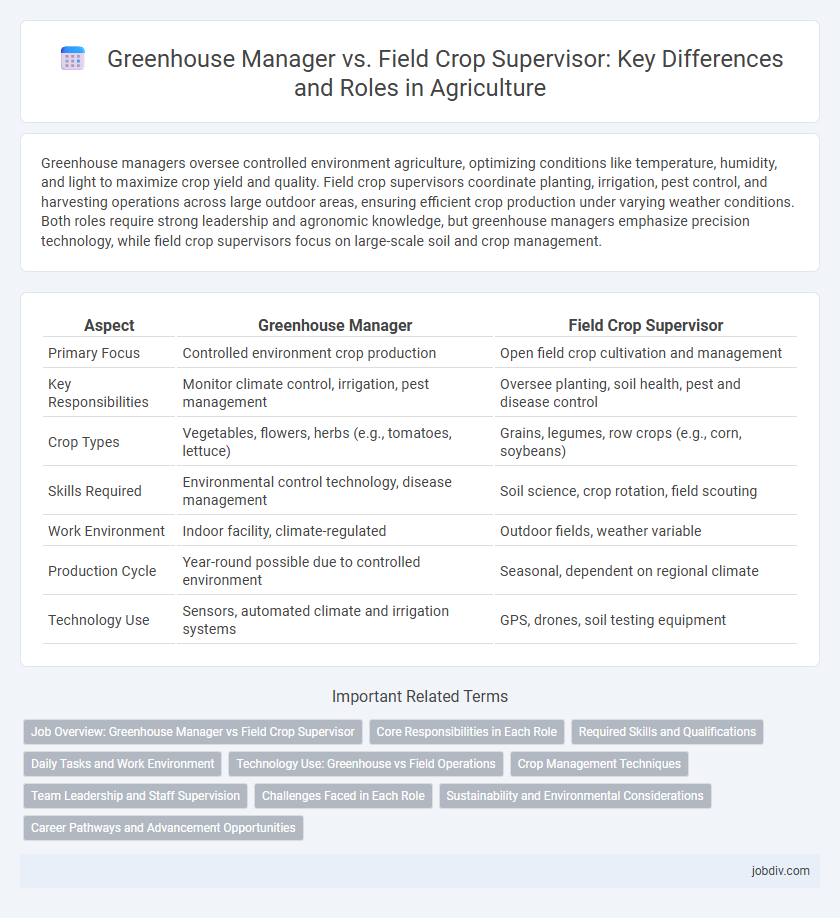Greenhouse managers oversee controlled environment agriculture, optimizing conditions like temperature, humidity, and light to maximize crop yield and quality. Field crop supervisors coordinate planting, irrigation, pest control, and harvesting operations across large outdoor areas, ensuring efficient crop production under varying weather conditions. Both roles require strong leadership and agronomic knowledge, but greenhouse managers emphasize precision technology, while field crop supervisors focus on large-scale soil and crop management.
Table of Comparison
| Aspect | Greenhouse Manager | Field Crop Supervisor |
|---|---|---|
| Primary Focus | Controlled environment crop production | Open field crop cultivation and management |
| Key Responsibilities | Monitor climate control, irrigation, pest management | Oversee planting, soil health, pest and disease control |
| Crop Types | Vegetables, flowers, herbs (e.g., tomatoes, lettuce) | Grains, legumes, row crops (e.g., corn, soybeans) |
| Skills Required | Environmental control technology, disease management | Soil science, crop rotation, field scouting |
| Work Environment | Indoor facility, climate-regulated | Outdoor fields, weather variable |
| Production Cycle | Year-round possible due to controlled environment | Seasonal, dependent on regional climate |
| Technology Use | Sensors, automated climate and irrigation systems | GPS, drones, soil testing equipment |
Job Overview: Greenhouse Manager vs Field Crop Supervisor
Greenhouse Managers oversee controlled environment agriculture, managing plant growth conditions, irrigation systems, and pest control to maximize crop yield and quality within greenhouse facilities. Field Crop Supervisors coordinate on-site crop production activities, including soil preparation, planting, fertilization, and harvesting, ensuring optimal growth for large-scale outdoor crops. Both roles require expertise in crop management but differ in operational settings, with Greenhouse Managers focusing on technology-driven environments and Field Crop Supervisors emphasizing fieldwork and weather-dependent cultivation.
Core Responsibilities in Each Role
A Greenhouse Manager oversees controlled environment agriculture, managing temperature, humidity, and irrigation systems to optimize plant growth and yield. A Field Crop Supervisor directs outdoor cultivation operations, coordinating planting schedules, pest control, and soil management to enhance crop productivity across large fields. Both roles require expertise in crop health monitoring and resource allocation, but differ in environment-specific practices and technology integration.
Required Skills and Qualifications
Greenhouse Managers require expertise in controlled environment agriculture, including proficiency in climate control systems, pest management, and hydroponic cultivation techniques. Field Crop Supervisors must possess strong knowledge of soil science, crop rotation, irrigation methods, and machinery operation, often supported by a background in agronomy or agricultural science. Both roles demand leadership skills, experience in data analysis for yield optimization, and compliance with agricultural regulations.
Daily Tasks and Work Environment
Greenhouse Managers oversee controlled environment agriculture, managing plant growth conditions such as temperature, humidity, and light, while coordinating planting and harvesting schedules. Field Crop Supervisors focus on outdoor crop production, monitoring soil health, irrigation, pest control, and machinery operations in open fields. Work environments differ significantly: Greenhouse Managers operate indoors with climate control technologies, whereas Field Crop Supervisors work primarily outdoors, adapting to weather conditions.
Technology Use: Greenhouse vs Field Operations
Greenhouse Managers leverage advanced climate control systems, automated irrigation, and sensor-based monitoring to optimize plant growth in controlled environments. In contrast, Field Crop Supervisors utilize GPS-guided machinery, remote sensing technologies, and data analytics to manage large-scale outdoor planting, irrigation, and harvesting efficiently. Both roles integrate technology to enhance productivity, but Greenhouse Managers focus on precision environmental control while Field Crop Supervisors emphasize spatial data and mechanization.
Crop Management Techniques
Greenhouse Managers utilize controlled environment agriculture techniques, optimizing temperature, humidity, and light to enhance crop growth and yield. Field Crop Supervisors focus on soil health, pest management, and irrigation strategies tailored to open-field conditions and large-scale farming operations. Both roles require expertise in crop rotation, nutrient management, and integrated pest control but differ significantly in their environmental control capabilities and operational scale.
Team Leadership and Staff Supervision
Greenhouse Managers excel in team leadership by overseeing controlled environment agriculture, managing specialized staff to optimize plant growth cycles and resource efficiency. Field Crop Supervisors focus on directing labor crews in open-field settings, coordinating planting, irrigation, and harvesting activities to maximize crop yields. Both roles require strong staff supervision skills, but Greenhouse Managers emphasize technical expertise and precision, while Field Crop Supervisors prioritize large-scale operational coordination and fieldwork logistics.
Challenges Faced in Each Role
Greenhouse Managers face challenges such as controlling environmental conditions, managing pest infestations, and optimizing resource use to maximize plant growth indoors. Field Crop Supervisors encounter difficulties including unpredictable weather patterns, soil variability, and coordinating large-scale labor for planting and harvesting. Both roles require specialized knowledge but differ significantly in operational complexity and environmental control.
Sustainability and Environmental Considerations
Greenhouse Managers prioritize controlled environment agriculture using energy-efficient systems and water recycling to minimize resource waste and reduce carbon footprints. Field Crop Supervisors implement sustainable land management practices like crop rotation, cover cropping, and integrated pest management to preserve soil health and support biodiversity. Both roles drive sustainability but differ in approach: greenhouse management emphasizes technological innovation, while field supervision relies on ecological balance.
Career Pathways and Advancement Opportunities
Greenhouse Managers specialize in controlled environment agriculture, overseeing plant production, climate control, and pest management, which leads to advancement opportunities in horticultural science, agribusiness management, or research roles. Field Crop Supervisors focus on large-scale crop production, soil management, irrigation, and machinery operation, with career pathways extending into farm management, agronomy consulting, or agricultural engineering. Both positions offer potential growth through certifications, advanced degrees in agricultural sciences, and leadership roles within agribusiness companies or government agencies.
Greenhouse Manager vs Field Crop Supervisor Infographic

 jobdiv.com
jobdiv.com